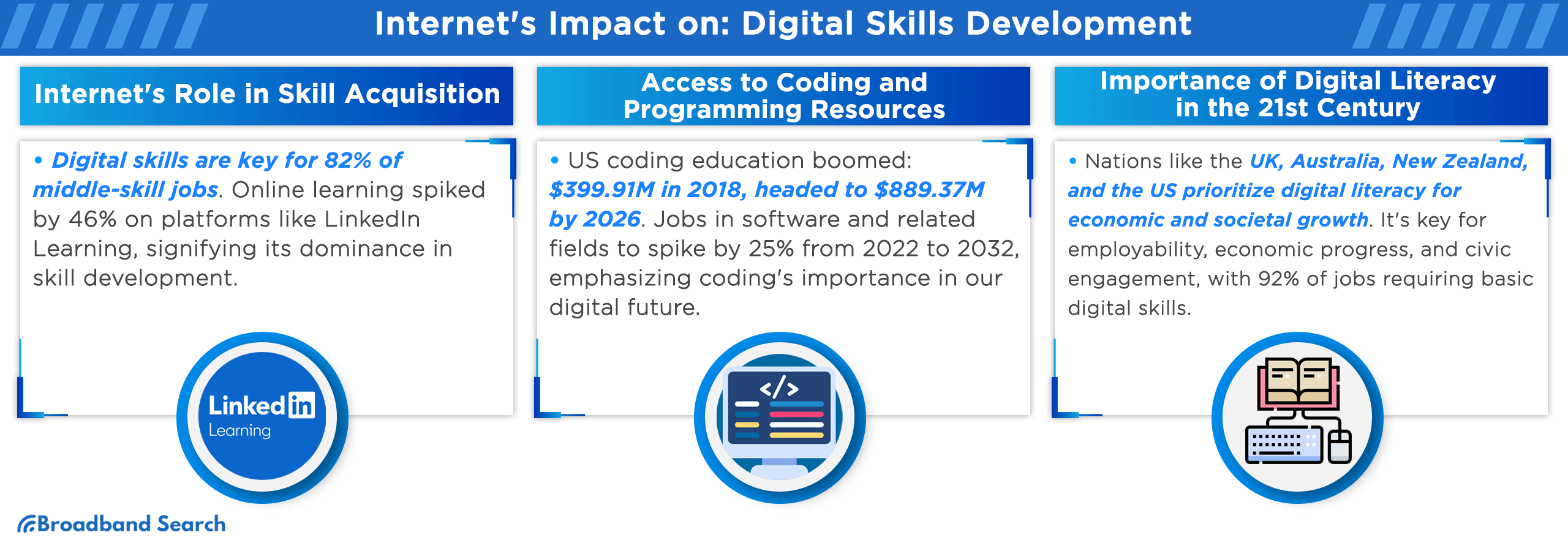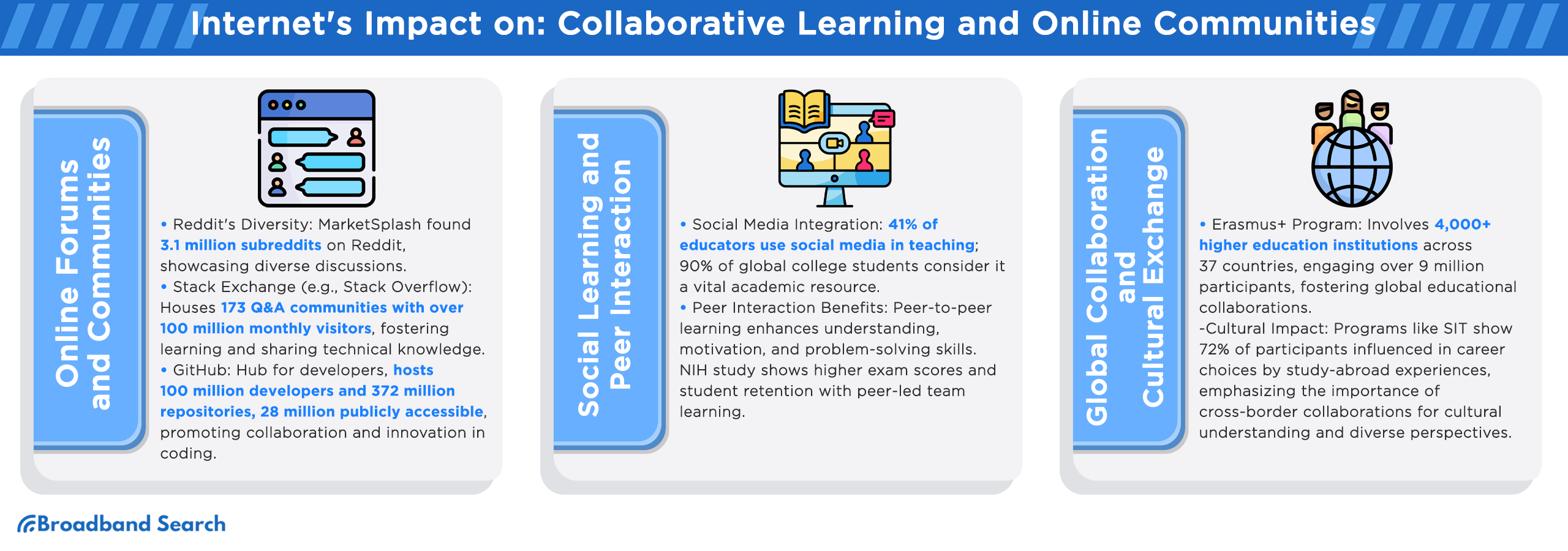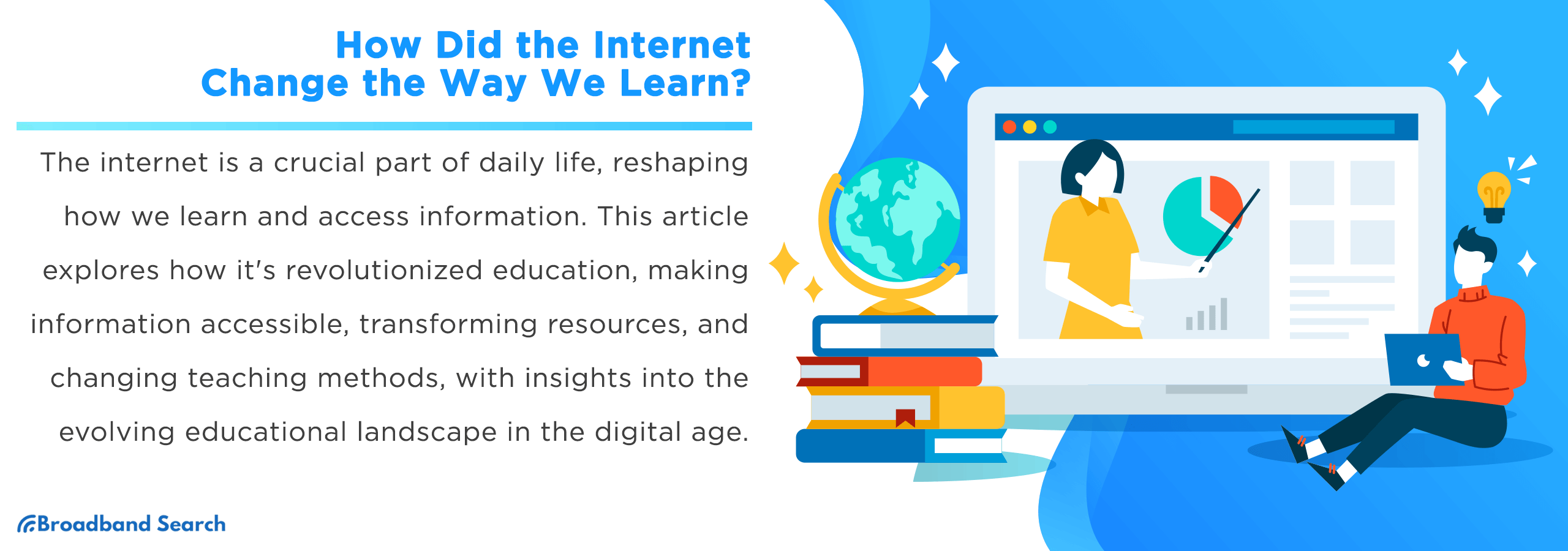The Internet, a vast global network interconnecting computers and devices, has become an indispensable part of our daily lives. Its profound influence extends beyond mere convenience, fundamentally reshaping how we acquire knowledge and learn.
Education, a cornerstone of personal growth and societal progress, relies heavily on access to information, resources, and innovative learning methods. In this article, we will delve into how the Internet has ushered in a transformative era of learning by democratizing access to information, revolutionizing educational resources, and redefining pedagogical approaches. We will explore the statistics and trends that underscore these changes, providing insights into the evolving landscape of education in the digital age.
Access to Information

Internet Penetration and Global Connectivity
Recent data illustrates the pervasive impact of the Internet, with a staggering 5.18 billion users worldwide. This figure represents a remarkable 64.6 percent of the global population.
The digital landscape has witnessed a decade of dynamic growth, with a standout year being 2015 when global internet users surged by an impressive 13.9%, according to data from Oberlo. Over the span from 2013 to 2023, the world experienced an astonishing influx of over 2.6 billion new internet users, marking an average annual growth rate of 7.4%.
Increased Availability of Information
The digital age has witnessed a remarkable shift in the realm of knowledge repositories. The Library of Congress, renowned as one of the world's largest libraries, houses 164 million items. In stark contrast, the Internet Archive, a digital preservation powerhouse, boasts an astounding collection, encompassing over 30 million books and texts, 8.9 million movies, videos, TV shows, 649,000 software programs, 13.2 million audio files, 3.8 million images, and a staggering archive of 580 billion web pages within the Wayback Machine, as of April 2021.
Within the vast expanse of the internet, we find a staggering range of digital realms, estimated to number anywhere between 1.5 billion to over 2 billion functional websites. This extraordinary digital landscape houses a wealth of information that transcends the confines of physical libraries.
Impact on Research and Knowledge Acquisition
Google's search engine alone processes over 8.5 billion searches per day, facilitating quick access to information for research purposes.
In May 2014, a notable study titled "The Number of Scholarly Documents on the Public Web" shed light on the expansive digital scholarly landscape. This research indicated that the World Wide Web is host to a vast repository of scholarly documents, predominantly in the English language, numbering an estimated 114 million. Google Scholar, a leading academic search engine, was found to index nearly 100 million of these documents. Furthermore, the study revealed that a substantial portion, approximately 27 million or 24%, were freely accessible, without necessitating any subscription or payment.
Online Education and E-Learning

Growth of Online Education Platforms
Online education platforms have undergone remarkable growth, reshaping the landscape of learning in recent years. The evolution of Massive Open Online Courses (MOOCs) offers a striking illustration of this transformation. From 2011 to 2021, the number of learners engaged with MOOCs surged exponentially, ascending from a mere 300,000 to a staggering 220 million.
Moreover, a 2018 study unveiled a significant trend among American students, with over 30% having experienced at least one online course. This statistic underscores the widespread adoption of online learning as a viable educational option. Furthermore, the online learning giant, Coursera, witnessed an extraordinary surge in student registrations in 2021, with a staggering 20 million new students joining its platform.
Flexibility and Convenience
A recent survey conducted by BestColleges delved into the preferences of prospective online students, current online students, remote learners, and online program graduates. Among these respondents, a striking 68% of current online students were juggling their studies with either full-time or part-time employment.
Furthermore, an overwhelming 95% of them had the added responsibility of caring for children under 18 in their households. These statistics underscore the pivotal role online education plays in accommodating the busy lives of working professionals and parents, providing them with opportunities to further their education without compromising their existing commitments.
Simultaneously, the landscape of learning devices is evolving, with mobile devices emerging as potent tools for education. According to SHIFT E-learning, an impressive 74% of learners have embraced the use of mobile devices for eLearning. This significant shift toward mobile learning not only reflects the adaptability of learners but also highlights the transformative impact of technology on the accessibility and convenience of educational resources.
Personalized Learning Experiences
Adaptive learning technologies have taken center stage, with higher education institutions embracing these data-driven methodologies as progressive means of instruction. This growing interest underscores a shift towards more tailored and responsive educational practices, marking a departure from traditional one-size-fits-all approaches.
Crucially, personalized learning has demonstrated its potential to yield substantial positive impacts. Early evidence suggests that personalized learning interventions can enhance student achievement, irrespective of their initial proficiency levels. Importantly, these benefits may not always be immediately apparent; instead, they may unfold over time as educators and institutions refine their personalized learning strategies. Analytical insights further suggest that the effects of personalized learning tend to become more pronounced as educational institutions gain experience in implementing these dynamic approaches.
Digital Skills Development

Internet's Role in Skill Acquisition
The digital era has ushered in a profound transformation in how individuals acquire and enhance their skills, driven by the evolving demands of the job market and the accessibility of online resources.
Demand for Digital Skills
The job market's hunger for digital skills is evident. In 2019, a Job Market Monitor study found that more than 8 in 10 middle-skill jobs (82%) mandated digital skills—a 4% increase since 2014. This surge underscores the integral role of digital proficiency in contemporary employment.
Online Learning's Ascendance
Online tutorials and courses have emerged as the primary avenues for skill development. Notably, in March on LinkedIn Learning, there was a remarkable 46% surge in the time spent learning by enterprise learners compared to February, translating to an additional 750,000 learning hours. To put this into perspective, it equates to 86 years of watching the entire Game of Thrones series approximately 11,800 times. This data showcases the rapid uptake of online learning as the preferred medium for upskilling and knowledge acquisition.
Access to Coding and Programming Resources
The landscape of coding education is marked by impressive growth. Notably, in the United States, the coding bootcamp market exhibited robust expansion, with a market size valued at $399.91 million in 2018. Projections indicate that this market is poised to further burgeon, expected to reach an estimated $889.37 million by 2026.
The allure of coding-related professions is undeniable. The U.S. Bureau of Labor Statistics reveals a compelling forecast—the overall employment of software developers, quality assurance analysts, and testers is projected to surge by 25% from 2022 to 2032. This growth trajectory significantly outpaces the average for all occupations, underscoring the pivotal role of coding skills in our digitally driven-future.
Importance of Digital Literacy in the 21st Century
In the ever-evolving landscape of digital literacy, countries such as the UK, Australia, New Zealand, and most recently, the United States, have firmly anchored digital literacy at the core of their digital economy strategies. This strategic move, initiated back in 2010, signifies a collective recognition of the pivotal role digital literacy plays in shaping not only individual prospects but the broader economic and societal landscape.
The profound impact of digital literacy ripples through various facets of society. Improved digital literacy has emerged as a linchpin, bolstering employability, catalyzing economic growth, and nurturing civic engagement. According to an analysis conducted by the National Skills Coalition, a staggering 92% of jobs now necessitate at least basic digital skills.
Collaborative Learning and Online Communities

Online Forums and Communities
In the expansive landscape of online discourse, a vibrant tapestry of discussion boards and forums thrives, encapsulating a multitude of subjects and interests. A striking illustration of this phenomenon is found in Reddit, where recent data from MarketSplash reveals an astonishing 3.1 million subreddits.
Successful online communities for learning include platforms like Stack Exchange and GitHub. Stack Exchange, exemplified by Stack Overflow, offers a valuable resource for individuals seeking prompt answers to their inquiries. Comprising 173 Q&A communities, with Stack Overflow at the forefront, these platforms collectively attract over 100 million monthly visitors, fostering a dynamic environment for learning and sharing technical knowledge.
GitHub, on the other hand, serves as an essential hub for developers, promoting collaboration and innovation within the coding community. GitHub's reach is staggering, boasting an impressive 100 million developers and an extensive repository count exceeding 372 million, with at least 28 million being publicly accessible.
Social Learning and Peer Interaction
The integration of social media platforms into education is on the rise. Recent data reveals that 41% of teachers in various educational institutions are incorporating social media into their teaching methods, reflecting a changing landscape in the classroom. Furthermore, a remarkable 90% of college students worldwide have embraced social media as a crucial academic resource, underlining its pervasive influence on modern learning experiences, both within and beyond traditional educational settings.
Peer-to-peer learning offers numerous benefits. Research indicates that peer interaction and collaboration can lead to a deeper understanding of content, increased motivation, and improved problem-solving skills. For instance, a study by the National Institutes of Health (NIH) found that peer-led team learning led to significantly higher exam scores and student retention rates.
Global Collaboration and Cultural Exchange
The landscape of international collaboration in education is undergoing a noteworthy transformation. The landscape of international collaboration in education is experiencing a remarkable transformation, exemplified by the surge in cross-border initiatives aimed at facilitating global knowledge exchange.
One standout illustration of this phenomenon is the Erasmus+ program, a powerful catalyst for international cooperation in education. This initiative has attracted participation from over 4,000 higher education institutions spanning 37 countries. Such widespread involvement underscores the program's remarkable success in transcending geographical boundaries and fostering educational collaborations on a global scale. Additionally, it's noteworthy that more than 9 million individuals have had the opportunity to participate in the Erasmus program since its inception.
Collaborations across borders bear substantial implications for cultural understanding and diversity. As exemplified by the experiences of program alumni from SIT, these initiatives yield profound effects. An insightful study revealed that an impressive 72% of participants attested to the significant influence of their study-abroad experiences on their career choices and employment prospects.
Challenges and Concerns
Digital Divide
Access to the internet continues to be a pressing global concern, with substantial disparities persisting across regions. In 2021, the International Telecommunication Union reported that nearly 47% of the world's population remained without internet access, reflecting significant regional discrepancies.
Notably, large emerging economies such as Russia, Turkey, Malaysia, China, and Brazil showcased relatively higher internet penetration rates, ranging from 60% to 72%. However, the digital divide looms larger in less affluent nations, primarily in sub-Saharan Africa and parts of Asia, where internet usage rates were notably lower, with figures like 39% in Nigeria, 30% in Indonesia, and 22% in India.
Information Overload
Navigating the vast sea of online information presents a formidable challenge in the digital age. This challenge is exemplified by the sheer volume of digital data, which surged to 64.2 zettabytes globally in 2020, as reported by Statista.
Dealing with information overload is a pervasive concern that affects individuals across age groups. A 2021 survey conducted by the National Institutes of Health (NIH) sheds light on this issue, revealing that children as young as 8 years old consume an average of 4 hours and 28 minutes of media per day. By the age of 12, this number escalates to a staggering 8 hours and 14 minutes daily. Furthermore, for each additional year of age, individuals are exposed to nearly an additional hour of media consumption.
Quality Control and Misinformation
- Misinformation is a prevalent issue online, even in educational contexts. According to a study by Stanford University, 82% of middle school students couldn't distinguish between a credible news article and a sponsored content piece.
- Institutions and individuals are taking proactive steps to combat misinformation in education. For instance, fact-checking organizations have gained prominence, with websites like Snopes and PolitiFact receiving millions of monthly visitors
The Bottom Line
The Internet has undeniably reshaped the landscape of education in profound ways. We have witnessed how it has democratized access to information, bridged geographical divides through online learning platforms, and fostered collaborative knowledge sharing through online communities. However, this transformative journey is not without its challenges.
To thrive in this digital era of learning, individuals must prioritize digital literacy skills. The ability to critically evaluate online content, discern credible sources, and navigate the vast information landscape is essential. It is the foundation upon which informed decision-making and meaningful learning experiences are built.
As we move forward, it is paramount that we embrace the opportunities presented by the Internet in education while remaining vigilant about its challenges. We must foster a culture of responsible online learning, where learners are equipped not only with technical skills but also with the critical thinking capabilities to navigate the complexities of the digital realm. By doing so, we can harness the Internet's transformative potential to empower learners, educators, and society as a whole, ensuring that the benefits of digital education are accessible to all.
FAQ
Are online courses as effective as traditional ones?
Online courses can be just as effective as traditional ones when designed well. Their effectiveness depends on factors like course quality, learner engagement, and the individual's ability to self-regulate their learning.
How can educators combat misinformation in online education?
Educators can teach critical thinking skills, encourage fact-checking, and promote the use of reliable sources. Incorporating media literacy into curricula can help students navigate the digital world more effectively.
What is the future of education with the Internet?
The future of education will likely involve a blend of traditional and online learning. Innovations like AI-driven personalized learning, virtual reality, and global collaboration will continue to shape education in the digital age.
How can I enhance my digital literacy skills?
You can enhance your digital literacy by taking online courses, staying informed about online safety practices, and practicing critical thinking when consuming digital content.
What are some recommended online resources for digital literacy and online learning?
There are many resources available, including MOOC platforms like Coursera and edX, online courses on LinkedIn Learning, and digital literacy tutorials from organizations like Mozilla and Common Sense Media.

